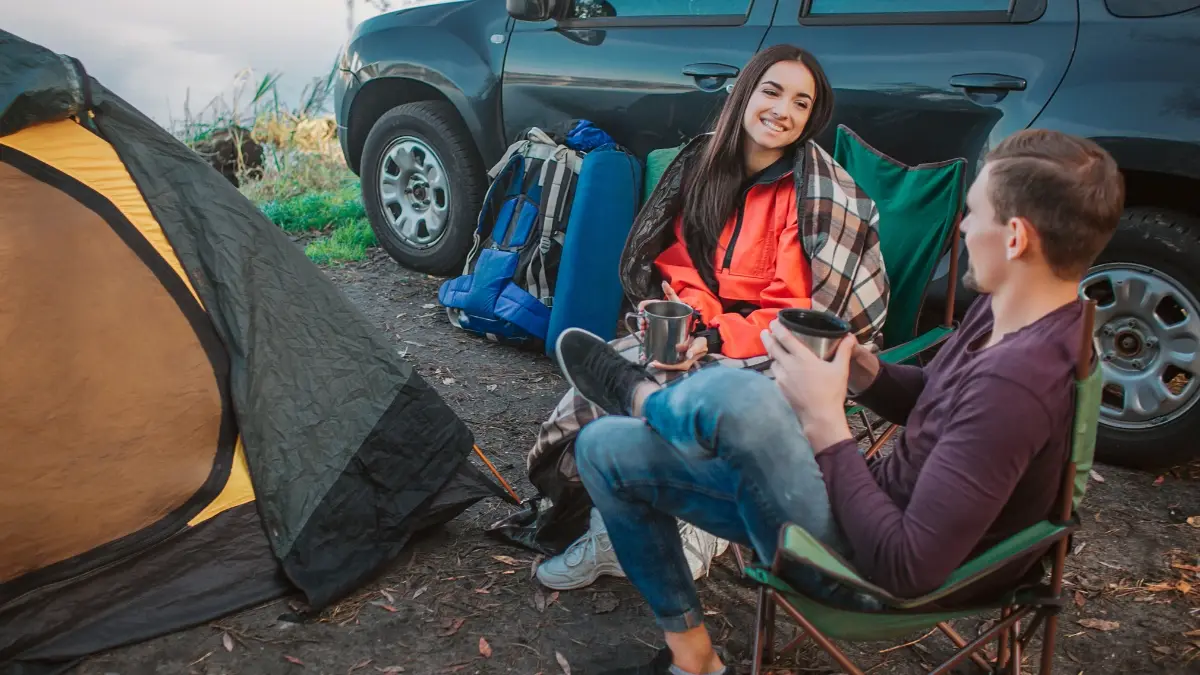Transitioning to full-time RV living is an adventure, but the question “What do I actually need to pack?” can turn excitement into pure anxiety. You’ve seen countless lists, but you’re worried about cluttering your tiny home with useless gadgets while forgetting the one thing that could leave you stranded.
This guide isn’t just another checklist. It’s a curated list of 21 full-time RV living essentials for 2025, backed by data, real-world RVer experience, and lessons learned the hard way.
It will ensure you start your journey prepared, not overloaded. We’ll cover what to pack for RV life to keep you safe, connected, and comfortable from day one.
Your First 5 Essentials for RV Setup and Safety
You’ve just backed into your very first campsite. Before you can even think about relaxing, you have to connect to the “grid.” This is where your most critical gear comes into play. These five items are not optional; they are the foundation of a safe setup.
1. Electrical Management System (EMS)

Do not plug your RV cord directly into the campground post. Ever. A cheap surge guard only protects from a single spike, like from lightning. An Electrical Management System (EMS) is a smart bodyguard for your entire electrical system.
- Why it’s essential: Campground wiring can be old, faulty, or incorrectly wired. An EMS protects you from:
- Low or high voltage (brownouts)
- Power surges
- Incorrectly wired pedestals
- The Proof: A faulty power post can fry your RV’s converter, microwave, and refrigerator. This is a $1,500+ repair bill. An EMS (like those from Progressive Industries or Southwire) costs around $300 and will simply shut off the power, saving your rig. RVers on forums like iRV2.net share stories all the time of their EMS saving them from bad power at multiple parks.
2. Water Pressure Regulator (with a Gauge)

Once your power is protected, you’ll reach for the water. That campground spigot can blast water at 100+ PSI. Your RV’s plumbing is only rated for about 40-50 PSI.
- Why it’s essential: High pressure will blow out your plastic fittings, crack pipes, and cause major floods inside your walls.
- What to get: Don’t get the cheap, simple brass cylinder. Get an adjustable regulator with a gauge. This lets you see the pressure and set it to a safe 45 PSI every single time.
Water Pressure: Don’t Risk It!
THE DANGER
High pressure will BLOW OUT fittings, CRACK pipes, and cause MAJOR FLOODS!
Caused by: Using no regulator or the cheap brass cylinder.
THE SOLUTION
Get an adjustable regulator WITH a gauge. This lets you SEE the pressure and set it to a SAFE 45 PSI every time.
3. Quality Sewer Hose Kit
This is the worst job in RVing. Do not make it worse by buying a cheap sewer hose. A “starter kit” hose is thin, will crack, and will leak. It’s a nightmare.
- Why it’s essential: A leak or split is unsanitary and awful to clean up.
- What to get: Invest in a quality kit like the Camco RhinoFLEX. It’s durable, and the 15′ or 20′ kit comes with all the fittings you need. A clear elbow connector is a huge help, as it lets you see when the tank is done flushing.
4. Leveling Blocks
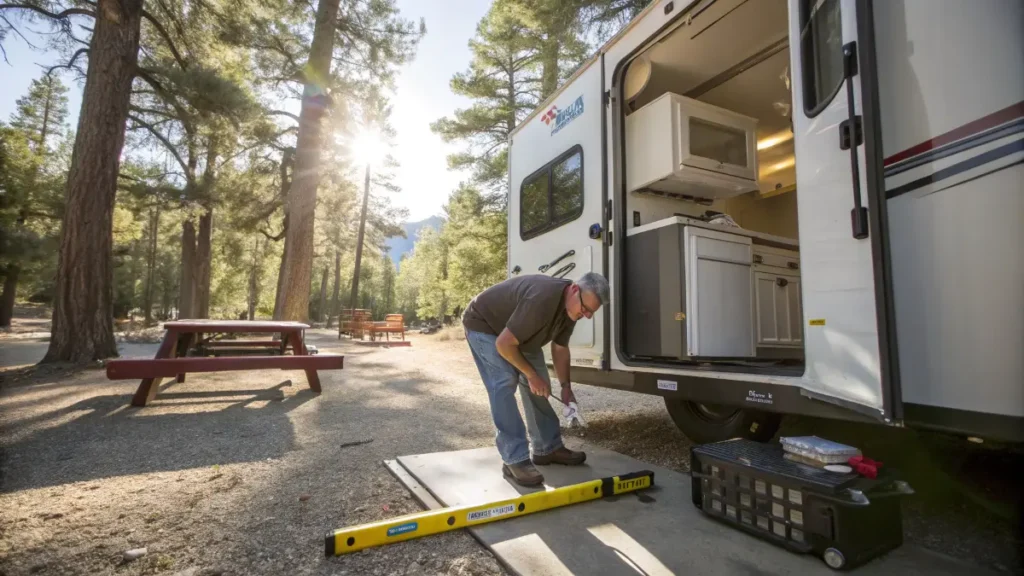
Being level isn’t just for comfort; it’s for function. Your RV refrigerator (if it’s an absorption model) must be level to work correctly. Running it off-level can permanently damage it.
- Why it’s essential: It ensures your fridge works, your shower drains, and you don’t feel like you’re walking uphill to bed.
- What to get: You can use simple Lynx-style blocks (like orange or yellow LEGOs) or faster ramp-style levelers like the Andersen Levelers. Either way, you need them. Campsites are almost never perfectly level.
5. Dedicated Drinking Water Hose
You need two hoses. One is for clean water, and one is for dirty jobs (like rinsing your sewer hose or black tank). Never, ever mix them up.
- Why it’s essential: Your drinking water hose must be lead-free, BPA-free, and rated for potable (drinking) water. This prevents a nasty plastic taste and keeps your water supply safe from contamination.
- What to get: Get a white or blue “drinking water safe” hose. Keep a separate, cheap green garden hose for all other tasks.
With these five items in this RV gear guide 2025, you can confidently and safely connect your RV to campground utilities. They are the first step for all RV living for beginners.
Staying Connected: 4 Tech Essentials for Modern RV Life

In 2025, RV living isn’t about disconnecting entirely. For many, it’s about staying connected on your own terms. With over 22% of the U.S. workforce (more than 32 million people) working remotely, reliable internet is a must-have. Here’s the tech that makes it possible.
6. Cell Signal Booster
You will park in places with one bar of cell service. A signal booster (like the WeBoost Drive Reach RV) doesn’t create a signal. It grabs that one weak bar, amplifies it, and rebroadcasts it inside your RV.
- Why it’s essential: This is the difference between “no service” and being able to make calls, send texts, and get a usable data connection for remote work. It’s a safety and work necessity.
7. Mobile Hotspot Device & Plan
Your phone’s hotspot is not enough for full-time work. It drains your battery and often has data caps or throttling. A dedicated hotspot device lets you use a different (or second) carrier and has a more powerful antenna.
- Why it’s essential: True internet for RV life means having options. Many full-timers have data plans from two carriers (like Verizon and T-Mobile). When one has no service, the other often does.
8. RV-Specific GPS
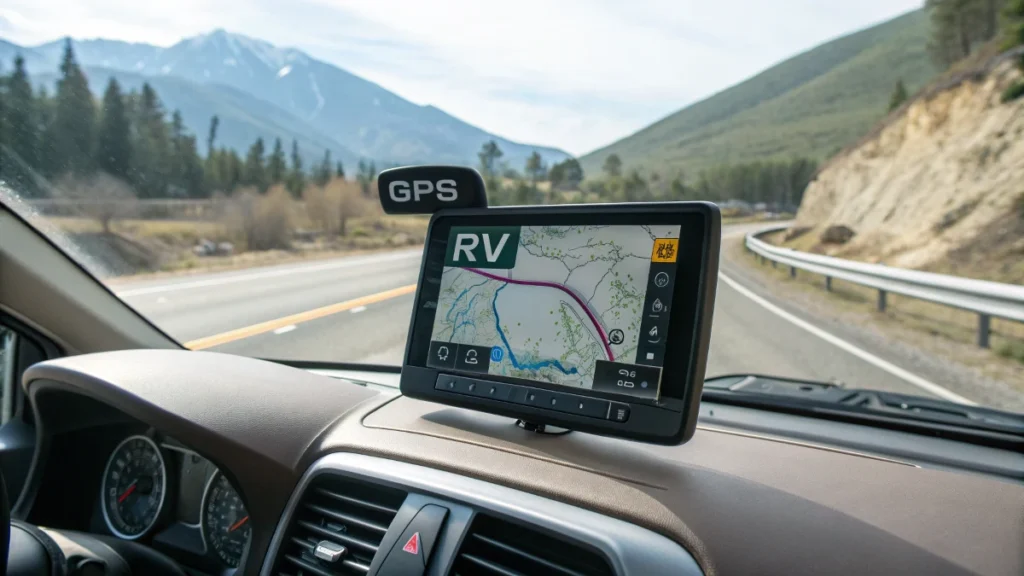
Stop using Google Maps to tow your rig. It will try to take you under a 12-foot bridge (your RV is likely 13.5 feet tall). It will also route you down steep mountain passes not safe for trailers.
- Why it’s essential: An RV-specific GPS (like a Garmin RV model) or an app like RV LIFE Trip Wizard lets you input your RV’s height, weight, and length. It then routes you only on roads you can safely fit on.
9. Portable Power Station
What happens when the campground power goes out or you want to boondock for a night? A portable power station (like a Jackery, Anker, or EcoFlow) is a game-changer.
- Why it’s essential: It’s a silent, gas-free generator. It lets you charge laptops, phones, and CPAP machines without firing up your loud onboard generator. It’s perfect for a few hours of off-grid work.
Now that you’re connected to the outside world, let’s focus on making the inside world your kitchen just as efficient.
4 RV Kitchen Essentials for Making Life Easier
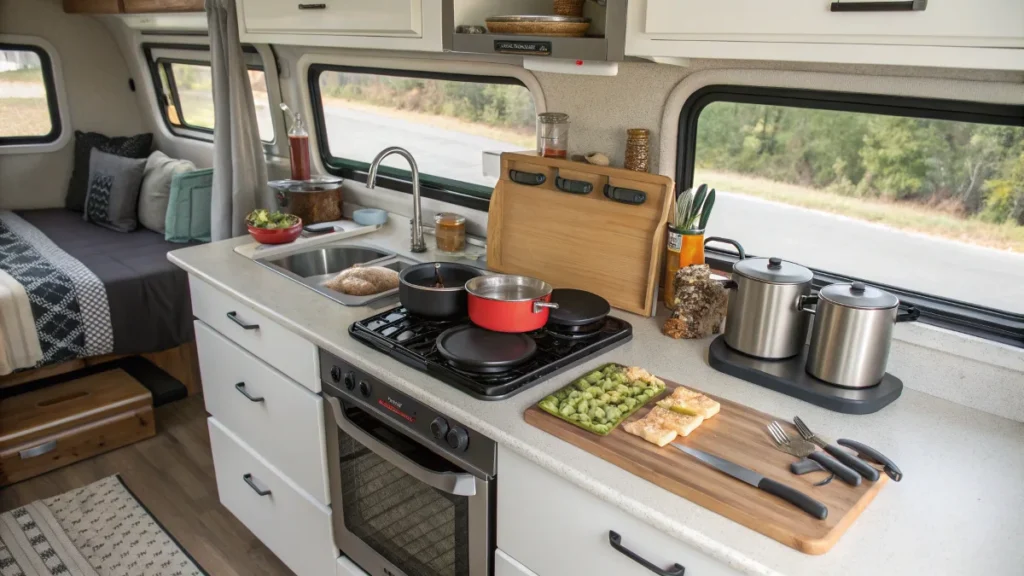
An RV kitchen is all about doing more with less. Forget single-use gadgets. These four items are the MVPs of the RV galley, saving you space, power, and time.
10. Multi-Cooker (Instant Pot)
This is the ultimate space-saving hero. An Instant Pot (or similar multi-cooker) replaces a slow cooker, pressure cooker, rice cooker, and yogurt maker.
- Why it’s essential: It cooks a full meal with one pot, which means fewer dishes. It also saves propane. In the summer, it’s a huge win because it doesn’t heat up your whole RV like the oven does.
11. Nesting Cookware & Collapsible Bowls
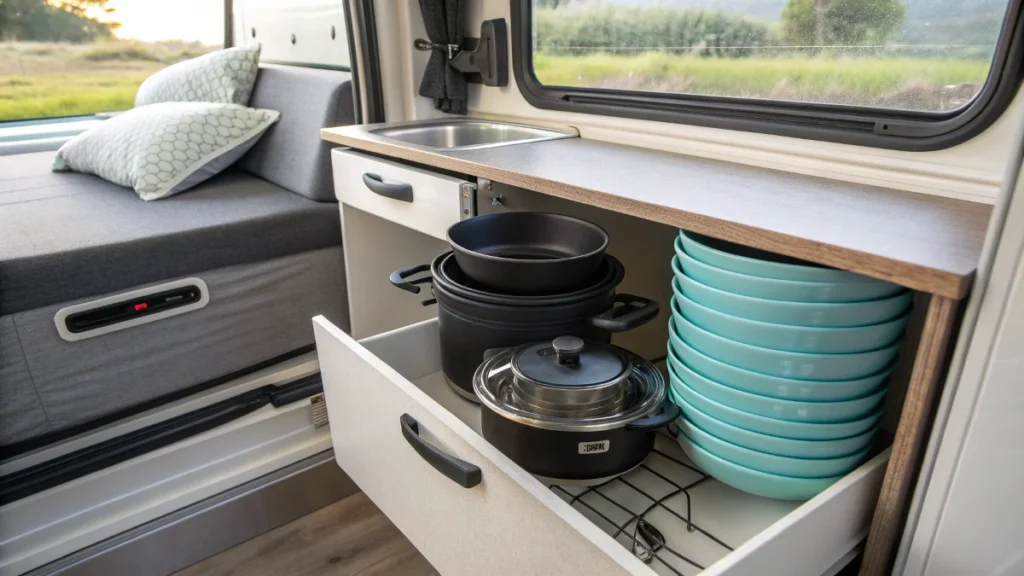
Storage space is your most valuable resource. A full set of pots and pans that stack into a single, small bundle is a must.
- Why it’s essential: These items (like Magma nesting pots or collapsible silicone bowls and colanders) take up a fraction of the cabinet space of a normal kitchen set. This is a non-negotiable part of what to pack for RV life.
12. High-Quality Water Filtration System
As you saw with the pressure regulator, campground water is a total unknown. It can be filled with minerals, taste like chlorine, or have sediment.
- Why it’s essential: You need safe, good-tasting drinking water.
- What to get: An inline Camco filter (the blue tube) is a good start for filtering sediment. But for full-time living, most RVers upgrade to a better system. This could be a countertop Berkey filter or a high-end external system like a Clearsource filter.
RV Water Purity System
Why Water Filtering is Essential
You need safe, good-tasting drinking water, especially on the road where sources vary.
13. Small, Powerful Cordless Vacuum
Your tiny home gets dirty fast. Dirt, pet hair, and crumbs will be everywhere. A broom and dustpan won’t cut it.
- Why it’s essential: A small, powerful, and easy-to-store cordless vacuum is a daily-use item. Models from Shark or a Dyson handheld are very popular with RVers because they can be mounted on a wall and get the job done quickly.
Creating Comfort: 5 Items That Make an RV a Home

Many new RVers quit in the first year. Why? Because the RV wasn’t comfortable. In RVer surveys, two of the top complaints are always poor sleep and moisture. These items fix those problems and make your rig a true home.
14. Dehumidifier
This is the 1 item most new RVers don’t know they need. You create moisture just by breathing, cooking, and showering. In an airtight RV, that moisture builds up, causing condensation on the windows and, eventually, mold.
- Why it’s essential: A small dehumidifier is your best defense against mold and mildew, which can destroy an RV and your health. It keeps the air feeling fresh and protects your investment.
15. Quality Mattress Topper or Replacement
The mattress that comes with your RV is terrible. It’s usually a thin piece of foam on a hard piece of wood.
- Why it’s essential: Good sleep is critical for long-term travel. A 3-inch memory foam mattress topper is a budget-friendly fix that will dramatically improve your sleep. Many full-timers just replace the mattress entirely.
16. Oxygenics Shower Head
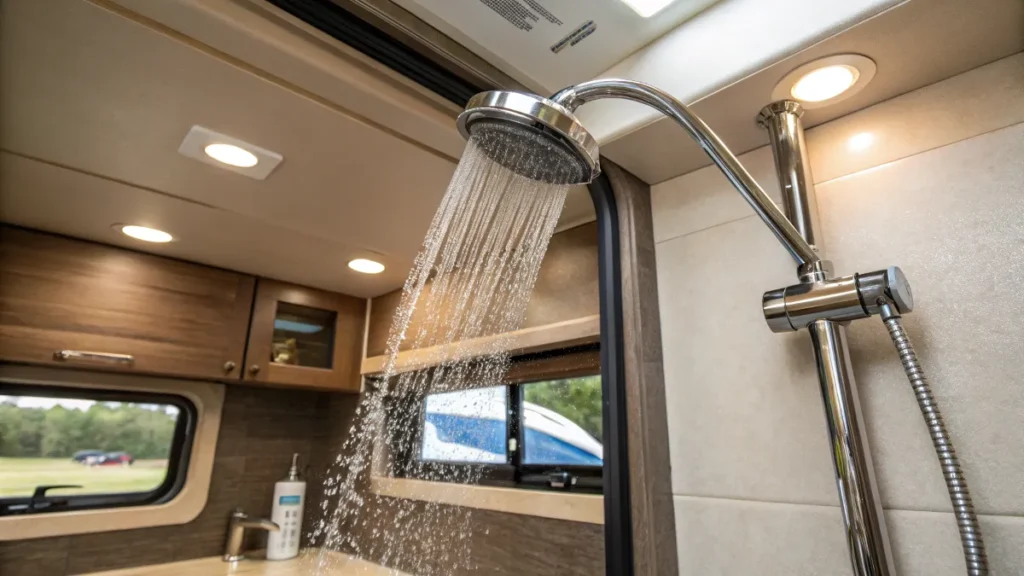
RV park water pressure is often awful. This, combined with low-flow RV shower heads, leads to a sad, dribbling shower.
- Why it’s essential: The Oxygenics brand shower head is a classic RV upgrade. It’s designed to increase the feeling of pressure even on a low-flow system. It gives you a great shower while still saving water.
17. Blackout Curtains or Shades
Campsites can be bright. Your neighbor might leave their porch light on all night. Blackout curtains or reflective shades (like Reflectix) are key.
- Why it’s essential: They guarantee you can sleep in the dark. As a bonus, they are a huge help with temperature control. They block the sun’s heat in the summer and keep the warmth inside in the winter.
18. Command Hooks & Strips
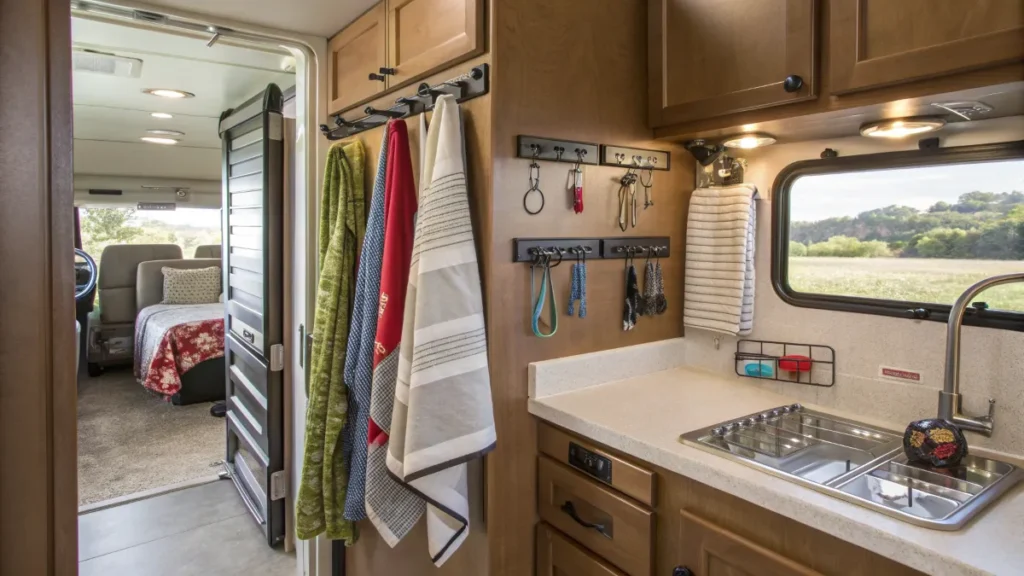
You can’t use nails in an RV. The walls are thin, and you don’t want to make permanent holes. Command Hooks are the RVer’s best friend.
- Why it’s essential: They let you hang everything—towels, coats, keys, pictures, and kitchen utensils without drilling. This makes the space truly your own and keeps it organized.
Your RV Maintenance & Emergency Kit (3 Must-Haves)

These three items will save you from the most common, and most dangerous, problems on the road.
19. Tire Pressure Monitoring System (TPMS)
This is a critical safety device. According to roadside assistance companies like Coach-Net, tire blowouts are the #1 reason for roadside calls. A blowout on a trailer can cause thousands of dollars in damage to the side of your rig in seconds.
- Why it’s essential: A TPMS has sensors that screw onto your tire valves. A monitor on your dash gives you real-time pressure and temperature readings. It will scream an alert if a tire is losing air or getting too hot, giving you time to pull over before it explodes.
20. Portable Air Compressor
Your RV tires need to be at the correct pressure every time you tow. This pressure changes with the temperature. You cannot rely on gas station air compressors; many can’t handle the high PSI (80-110+) of RV tires.
- Why it’s essential: A 12-volt portable air compressor (like a Viair) is a must-have. It lets you top off your tires at your campsite before you ever hit the road. It ensures safety and extends the life of your tires.
21. The “Big Three” in a Basic Toolkit
You don’t need a full mechanic’s garage, but you need these three things. They will solve 80% of your minor issues.
- Why it’s essential:
Essential Toolkit
Multi-Bit Screwdriver
RVs are held together with screws. They will rattle loose.
Adjustable Wrench
For tightening water fittings and battery terminals.
Eternabond Roof Tape
Not duct tape! Creates an instant, permanent, waterproof seal. It can save you from a trip-ending disaster.

